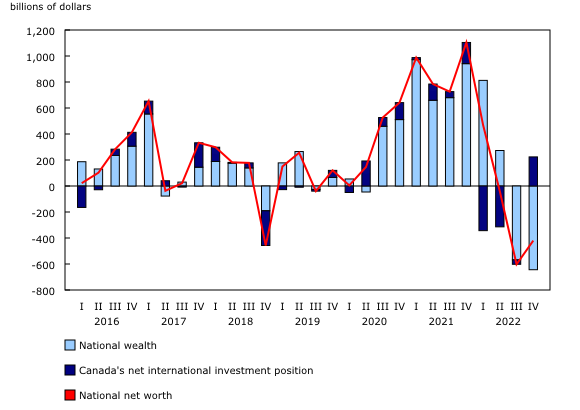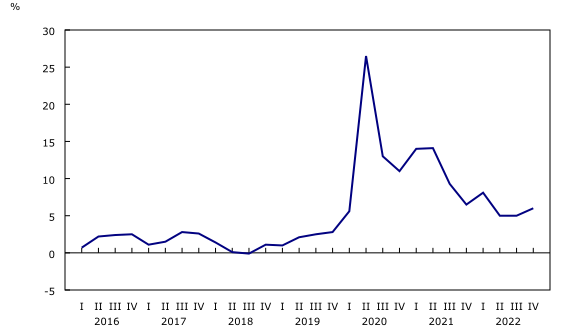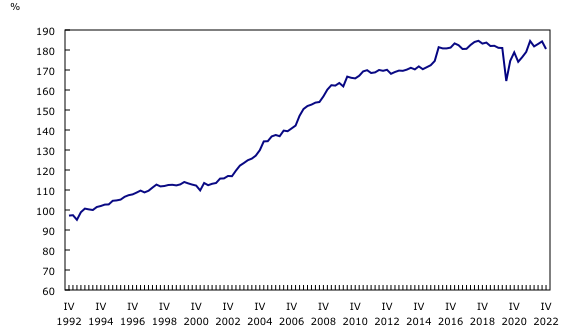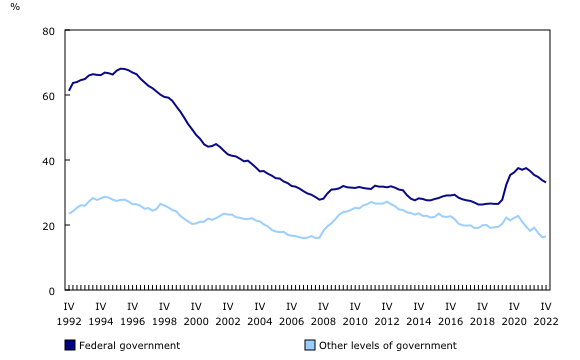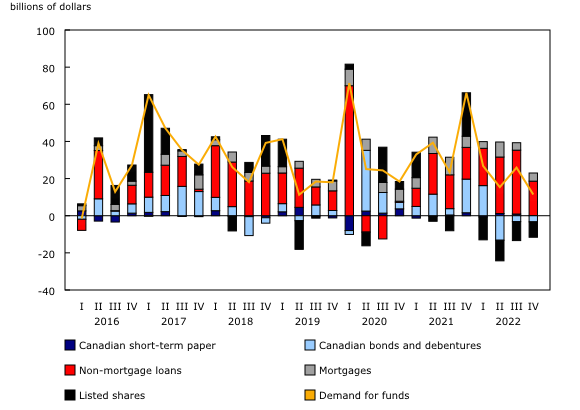National balance sheet and financial flow accounts, fourth quarter 2022
Released: 2023-03-13
National net worth continues to fall despite rebound in international investment position
National net worth, the sum of national wealth and Canada's net foreign asset position, dropped 2.4% from the third quarter to $16,769.7 billion at the end of the fourth quarter. This followed a decrease of $602.2 billion (-3.4%) in the third quarter, which was the largest quarterly decline since the fourth quarter of 2008. Compared with the end of 2021, national net worth was down 3.4% by the end of 2022. However, since the end of 2019, national net worth has expanded 34.8%, more than double the pace of growth over the three-year period up to the end of 2019 (+15.4%).
The total value of non-financial assets in Canada, also referred to as national wealth, declined 3.9% from the third quarter to $15,930.0 billion in the fourth quarter of 2022, the largest quarterly decrease since the end of 2008. This was attributable to a $615.2 billion decline in the value of Canada's natural resources (excluding land). After jumping almost $900 billion in the first two quarters of 2022, the value of natural resources finished the year down $87.6 billion, as resource wealth returned to valuations seen late in 2021. Deepening the decline in national wealth, the value of residential real estate continued to fall for a third consecutive quarter, down $109.2 billion to $8,240.6 billion in the fourth quarter of 2022. However, the drop in the value of residential real estate was less pronounced than those recorded in the second and third quarters of 2022.
Highlights
On a nominal basis, the Canadian economy contracted for the second consecutive quarter in the fourth quarter as compensation of employees posted a second straight quarter of slower growth and corporate incomes weakened. Real gross domestic product (GDP) was flat, as higher household and government spending and improved net trade was offset by slower inventory accumulation and declines in business investment in machinery and equipment and housing. Businesses continued to work through supply-chain challenges while also managing staff recruitment and retention as demand for labour remained elevated.
The savings rate moved higher in the fourth quarter as increased government transfers boosted household disposable income, which grew at almost twice the rate of household consumption. Household mortgage borrowing activity continued to decelerate, and housing demand continued to soften, as the Bank of Canada increased the policy interest rate to 4.25% in the fourth quarter of 2022—with a further increase to 4.5% announced in January 2023. Households continued to adjust their investment behaviour in response, with net mutual fund investment outflows and an expansion of fixed-term deposits.
Overall, 2022 marked a volatile year for asset classes, with bond yields spiking to prices not seen since the 2008 financial crisis and equity markets declining for the first time since the first quarter of 2020. The price of energy was influenced by precipitous global factors, rising sharply at the start of 2022 and retreating considerably by the end of the year. House prices were no different, declining sharply mid-year as the Bank of Canada accelerated its tightening of monetary policy. The Canadian dollar depreciated considerably against the US dollar over the year and after two years of elevated borrowing, the federal government demand for funds fell considerably in the last half of 2022.
Canada's net foreign asset position, the difference between Canada's international financial assets and international liabilities, rose by $223.9 billion from the third quarter to $839.7 billion at the end of the fourth quarter. This marked the first quarterly increase since the fourth quarter of 2021, as global equity markets rebounded. Overall, on an annual basis, Canada's international investment position weakened by $467.7 billion in 2022.
Household savings rate rises in the fourth quarter, remains elevated
In the fourth quarter, seasonally adjusted household compensation (nominal terms) grew by a modest 1.2% from the third quarter. Overall, growth in household disposable income (+3.0%) was nearly double that of household consumption (+1.6%), which boosted household net savings and consequently pushed the savings rate up to 6.0% in the fourth quarter, well above the 2.8% rate recorded in the fourth quarter of 2019.
Households continue sell off of mutual fund shares as currency and deposits surpass $2 trillion
During the fourth quarter, households continued to divest from their mutual fund investments, recording net redemptions of $3.1 billion, the third consecutive quarter of outflows. Over 2022, household net redemptions of mutual fund shares totalled $15.9 billion; this compares with record net mutual fund investment of $130.5 billion a year prior.
As interest rates continue to rise, households have re-oriented their preferences towards assets with less exposure to market volatility and for which rising interest rates may yield relative gains in investment income. This includes a fourth consecutive quarter of net inflows into money market mutual funds, which invest in short-term fixed-income securities, and significant growth in fixed-term deposit assets, which include guaranteed investment certificates.
Household currency and deposits surpassed the $2 trillion mark in the fourth quarter as households recorded inflows of $45.9 billion, with some of this addition likely a re-allocation from other investments. Over 2022, household holdings of currency and deposits expanded by $159.6 billion, greater than the $104.3 billion expansion recorded during 2021.
Household net worth rises, buoyed by recovering equity markets, but hampered by falling house prices
Household sector net worth—the value of all assets minus all liabilities—rose $181.0 billion or 1.2% from the third quarter to reach $15,320.4 billion in the fourth quarter. This followed two quarters of notable declines in which weakening bond, equity and housing markets combined to dampen household wealth. In the fourth quarter, household wealth was buoyed by recovering equity markets despite the continued drag from falling house prices. Household sector net worth ended the year 4.7% lower than 2021, as households relinquished roughly one-third of the gains in wealth recorded over 2021. Annual declines in both the value of financial and non-financial assets combined with consistently growing liabilities put downward pressure on household net worth in 2022.
The value of households' total financial assets rose 3.4% (+$305.0 billion) in the fourth quarter and that increase was partially offset by a $105.0 billion drop in the value of non-financial assets, as the decline in real estate valuations and activity continued, albeit to a lesser degree, and the housing market grappled with still higher interest rates. Financial liabilities, composed primarily of mortgage and non-mortgage debt, were up $19.0 billion from the third quarter to the fourth quarter.
Residential real estate decline slows
The value of household residential real estate, comprised of both structures and the underlying land, declined by 1.4% (-$104.1 billion) from the third quarter to the fourth quarter, following two consecutive quarters of sharper declines that, combined, shed nearly three-quarters of a trillion dollars from household real estate wealth. The policy interest rate increased twice during the fourth quarter to reach 4.25% from 3.25% at the end of the third quarter, as the Bank of Canada announced seven increases in 2022 overall. On a seasonally adjusted basis, the total value of resale units sold fell 2.2% from the third quarter to the fourth quarter and was 23.4% lower in 2022 compared with 2021 (which was a record high for residential real estate sales). By the end of 2022, the total value of residential real estate in Canada was 6.8% lower than the start of the year, but 32.8% higher than the end of 2019.
Declining residential real estate wealth was fuelled by a fall in the value of residential land, which declined 17.5% over 2022, as the value of residential structures grew 9.9%. Statistics Canada's Residential Building Construction Price Index, which measures the quarterly change over time in the prices that contractors charge to construct residential buildings in 11 census metropolitan areas (CMAs), reported that building construction costs rose 15.4% in 2022 from the previous year, as "a combination of increasing demand for construction and supply challenges due to labour shortages resulted in limited availability and higher prices for materials and labour in the construction industry."
The number of resale units sold in the fourth quarter of 2022 was 38.0% lower than in the fourth quarter of 2021, likely a result of the many interest rate hikes throughout 2022. Interest rate hikes also impacted affordability, with mortgage payments 19.7% higher in the fourth quarter of 2022 than in the fourth quarter of 2021. The Bank of Canada's most recent release of its Housing Affordability Index, which measures the ratio of housing-related costs, simulating conditions experienced by a new buyer in today's market, to average household disposable income, shows that, in the fourth quarter of 2022, housing costs relative to disposable income fell for the first time after six consecutive quarters of increases. Despite this decrease, the ratio remained at a level not seen since 1990, when interest rates exceeded 10% and house prices were considerably lower.
Household borrowing slows for second consecutive quarter
On a seasonally adjusted basis, the pace of credit market borrowing slackened once again, with households adding $23.7 billion of debt in the fourth quarter, down from $33.7 billion in the third quarter, and the slowest pace since the middle of 2020. As households reacted to increased interest rates, mortgage demand slowed to $17.2 billion in the fourth quarter of 2022, the slowest pace since the beginning of 2019. By comparison, households demanded $120.3 billion in mortgage debt over the first three quarters of 2022. Across all four quarters of the year, credit market borrowing in 2022 ($165.8 billion) was 14.2% lower than in 2021 ($193.1 billion), but remained higher than 2019 levels ($92.6 billion).
In terms of new residential mortgage funds advanced by financial institutions, which include chartered banks, the popularity of variable rate mortgages continued to fall given the interest rate environment. Variable rate borrowing represented 24.3% of new funds advanced versus fixed rate alternatives in the fourth quarter, compared with 53.5% for variable rate borrowing in the fourth quarter of 2021. Overall, variable rate mortgages represented just over one-third (33.7%) of total outstanding mortgage debt in the fourth quarter of 2022, down from 34.7% in the previous quarter.
The stock of household credit market debt (consumer credit, and mortgage and non-mortgage loans) grew 0.8% from the third quarter to reach $2,818.5 billion in the fourth quarter, with mortgage debt ($2,089.8 billion) accounting for nearly three-quarters of the total.
Households' interest payments continue rapid rise
On a seasonally adjusted basis, household credit market debt as a proportion of household disposable income improved to 180.5% in the fourth quarter from 184.3% in the third quarter, and was down from 184.5% at the end of 2021. In other words, there was $1.81 in credit market debt for every dollar of household disposable income in the fourth quarter of 2022. Households' disposable income was 3.0% higher in the fourth quarter compared with the previous quarter, while household credit market debt edged up 0.8%.
The household debt service ratio, measured as total obligated payments of principal and interest on credit market debt as a proportion of household disposable income, was 14.33% in the fourth quarter, a slight rise from 14.24% in the third quarter. The growth in household disposable income before interest payments (+3.8%) in the fourth quarter was outpaced by another significant rise in debt payments (+4.4%). Additional upward pressure on debt payments remains, as those with variable rate mortgages increase their payments as a result of hitting their trigger rate, and some fixed-rate mortgage holders near the end of their terms must then negotiate new lending agreements.
Interest payments expanded 14.1% from the third quarter to the fourth quarter, surpassing the record increase set in the third quarter. Meanwhile, obligated payments of principal declined 5.3% as the significant stock of variable rate mortgages likely allowed interest payments to further adjust without a concomitant rise in principal. Compared with the fourth quarter of 2021, payments of interest rose an unprecedented 45.0% in the fourth quarter of 2022, while obligated payments of principal fell 7.0%. According to the Bank of Canada's fourth quarter edition of the Survey of Consumer Expectations, a growing share of Canadians plan to further cut or postpone purchases in the coming months, while "about 6 in 10 respondents reported having more difficulty accessing credit now than they did one year ago."
Federal government appetite for debt diminishes in 2022
The federal government demand for credit market debt was $0.3 billion in the fourth quarter, compared with $3.2 billion of net debt repayments in the third quarter. Net issuances of treasury bills (+$3.7 billion) were largely offset by net redemptions of federal government bonds (-$2.7 billion) and net repayments of non-mortgage loans (-$0.7 billion). Over 2022, federal government demand for credit market debt was $27.8 billion, a sharp decline from 2021, when demand for credit market debt totalled $113.0 billion.
For a second consecutive quarter, non-residents were the largest buyers of federal government bonds, purchasing $16.0 billion worth in the fourth quarter of 2022. Meanwhile, the Bank of Canada continued to shrink its balance sheet and over the course of 2022, the Bank allowed $57.2 billion worth of federal government bonds to mature without replacement; this represented 12.9% of the Bank of Canada's outstanding federal bond holdings entering 2022.
Demand for credit market debt from the other levels of government (excluding social security funds) was $6.7 billion in the fourth quarter. This demand was mainly composed of $7.0 billion in net issuances of short-term paper and was partially offset by $0.6 billion in net retirements of bonds.
Federal government net financial liabilities as a proportion of gross domestic product declines, while those of other levels of government rise
The ratio of federal government net financial liabilities (the book value of total financial liabilities less the market value of total financial assets) to gross domestic product (GDP) declined to 33.1% in the fourth quarter from 33.8% in the third quarter as growth in GDP outpaced net financial liabilities. On the other hand, the ratio of other levels of government net financial liabilities to GDP increased slightly from 16.3% to 16.4% over the same period, as growth in liabilities and a slight decline in the value of assets led to net financial liabilities outpacing growth in GDP.
Private non-financial corporations' demand for funds lowest since the second quarter of 2019
In the fourth quarter, the demand for funds by private non-financial corporations slowed to $11.4 billion from $25.9 billion in the previous quarter. Borrowing was mainly in the form of non-mortgage loans (+$18.5 billion) and mortgage loans (+$4.4 billion) in the fourth quarter. This was partially offset by net redemptions of listed shares (-$8.3 billion) and bonds (-$3.3 billion). Listed shares recorded their largest annual net redemption on record (-$41.9 billion) as share repurchases continued to fuel redemptions, while non-mortgage loan borrowing was a record $103.3 billion for the year. However, net retirements in debt securities were an unprecedented $2.0 billion for 2022, as the demand for funds in 2022 stood at $79.5 billion, the lowest amount since 2016 (+$77.6 billion).
Private non-financial corporations' mineral and energy reserves, which are significant components of their natural resource wealth and net worth, decreased 29.6% in the fourth quarter of 2022, compared with the previous quarter. This was the second consecutive decline after eight consecutive quarterly increases and was primarily the result of falling energy prices. The value of natural resources (excluding land) fell 1.7% over the course of 2022 but was still more than double the level from the end of 2020.
Financial sector supply of funds robust in 2022, despite quarterly slowdown
Financial corporations delivered $19.2 billion of funds to the economy through financial market instruments in the fourth quarter, the smallest provision of funds since the first quarter of 2021. The supply of funds was primarily in the form of non-mortgage (+$26.8 billion) and mortgage (+$20.0 billion) loans offset primarily by bonds (-$14.0 billion) and listed shares (- $15.4 billion). The total supply of funds in 2022 was $402.1 billion, well below the record set in 2020 ($609.0 billion). By comparison, from 2009 to 2018, the average annual supply of funds was $234.3 billion.
Note to readers
Revisions
This release of the national balance sheet and financial flow accounts for the fourth quarter of 2022 includes revised estimates from the first quarter to the third quarter of 2022. These data incorporate new and revised data, as well as updated data on seasonal trends.
Data enhancements to the national balance sheet and financial flow accounts, such as the development of detailed counterparty information by sector, will be incorporated on an ongoing basis. To facilitate this initiative as well as others, it is necessary to extend the annual revision period (normally the previous three years) at the time of the third quarter release.
Support measures by governments
Details on some of the more significant federal government COVID-19 support measures are now available in "Federal government COVID-19 response measures in the System of Macroeconomic Accounts, quarterly" (36-10-0687).
Financial and wealth accounts on a from-whom-to-whom basis: Selected financial instruments
The data visualization product "Financial accounts on a from-whom-to-whom basis, selected financial instruments" has been updated with data from the first quarter to the fourth quarter of 2022.
Next release
Data on the national balance sheet and financial flow accounts for the first quarter of 2023 will be released on June 14, 2023.
Overview of the financial and wealth accounts
This release of the financial and wealth accounts comprises the National Balance Sheet Accounts (NBSA), the Financial Flow Accounts (FFA), and the other changes in assets account.
The NBSA are composed of the balance sheets of all sectors and subsectors of the economy. The main sectors are households, non-profit institutions serving households, financial corporations, non-financial corporations, government, and non-residents. The NBSA cover all national non-financial assets and all financial asset-liability claims outstanding in all sectors. To improve the interpretability of financial flows data, selected household borrowing series are available on a seasonally adjusted basis (table 38-10-0238-01). All other data are unadjusted for seasonal variation. For information on seasonal adjustment, see Seasonally adjusted data – Frequently asked questions.
The FFA articulate net lending or borrowing activity by sector by measuring financial transactions in the economy. The FFA arrive at a measure of net financial investment, which is the difference between transactions in financial assets and liabilities (for example, net purchases of securities less net issuances of securities). The FFA also provide the link between financial and non-financial activity in the economy, which ties estimates of saving and non-financial capital acquisition (for example, investment in new housing) to the underlying financial transactions.
While the FFA record changes in financial assets and liabilities between opening and closing balance sheets that are associated with transactions during the accounting period, the value of assets and liabilities held by an institution can also change for other reasons. These other types of changes, referred to as other economic flows, are recorded in the other changes in assets account.
There are two main components to this account. One is the other changes in the volume of assets account. This account includes changes in non-financial and financial assets and liabilities relating to the economic appearance and disappearance of assets, the effects of external events such as wars or catastrophes on the value of assets, and changes in the classification and structure of assets. The other main component is the revaluation account, showing holding gains or losses accruing to the owners of non-financial and financial assets and liabilities during the accounting period as a result of changes in market price valuations.
At present, only the aggregate other change in assets is available within the Canadian System of Macroeconomic Accounts; no details are available on the different components.
Definitions concerning financial indicators can be found in "Financial indicators from the National Balance Sheet Accounts" and in the Canadian System of Macroeconomic Accounts glossary.
Distributions of household economic accounts
The NBSA for the household sector is allocated across a number of socioeconomic dimensions as part of the distributions of household economic accounts. Data on wealth and its components by income quintile, age group, generation and region are available in tables 36-10-0660-01, 36-10-0661-01, 36-10-0664-01, and 36-10-0665-01.
The methodology for Distributions of household economic accounts wealth estimates can be found in the article "Distributions of Household Economic Accounts, estimates of asset, liability and net worth distributions, 2010 to 2019: Technical methodology and quality report."
Products
The document, "An overview of revisions to the Financial and Wealth Accounts, 1990 to 2022," which is part of Latest Developments in the Canadian Economic Accounts (13-605-X), is now available.
The data visualization product "Financial accounts on a from-whom-to-whom basis, selected financial instruments," which is part of Statistics Canada – Data Visualization Products (71-607-X), is now available.
As a complement to this release, you can also consult the data visualization product "Distributions of Household Economic Accounts, Wealth: Interactive tool," which is part of Statistics Canada – Data Visualization Products (71-607-X).
As a complement to this release, you can also consult the data visualization product "Securities statistics," which is part of Statistics Canada – Data Visualization Products (71-607-X).
The Economic accounts statistics portal, accessible from the Subjects module of our website, features an up-to-date portrait of national and provincial economies and their structure.
The User Guide: Canadian System of Macroeconomic Accounts (13-606-G) is available.
The Methodological Guide: Canadian System of Macroeconomic Accounts (13-607-X) is available.
The Canada: Economic and Financial Data - International Monetary Fund's Special Data Dissemination Standard Plus (SDDS Plus) product (13-608-X) "Other Financial Corporations Survey," also known as "Assets and liabilities of other financial corporations by sector, market value, quarterly" (Table 36-10-0668-01), is available.
Contact information
For more information, or to enquire about the concepts, methods or data quality of this release, contact us (toll-free 1-800-263-1136; 514-283-8300; infostats@statcan.gc.ca) or Media Relations (statcan.mediahotline-ligneinfomedias.statcan@statcan.gc.ca).
- Date modified:



